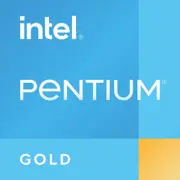Intel Pentium Gold 4415U

Intel Pentium Gold 4415U: A Budget Processor for Everyday Tasks
April 2025
Architecture and Process Node: Kaby Lake in the Era of Miniaturization
The Intel Pentium Gold 4415U processor, released in 2017 on the Kaby Lake architecture, is still found in budget laptops. Its key specifications include:
- 2 cores and 4 threads thanks to Hyper-Threading.
- Base frequency: 2.3 GHz (no turbo mode).
- 14nm process node, which looks outdated by 2025 compared to Apple’s 5nm chips and AMD's 4nm solutions.
- Integrated Intel HD 610 Graphics: 12 execution units, clocked up to 950 MHz.
The Kaby Lake architecture is optimized for energy efficiency but not for multi-threaded workloads. The integrated GPU can handle 4K video decoding (HEVC, VP9) but is not suited for 3D rendering.
Power Consumption and TDP: Balancing Power and Battery Life
The processor's TDP is 15W, allowing it to be used in thin laptops with passive or compact active cooling. For example, in devices like the Lenovo IdeaPad Slim 3 (body thickness – 17.9mm), the radiator and fan occupy minimal space.
The advantage of this approach is low noise levels: even under load, the fan rarely spins up to high RPMs. However, the lack of a turbo mode limits peak performance.
Performance: What Can the Pentium Gold 4415U Do in 2025?
Office Work and Multimedia
- Browser: 5-7 tabs in Chrome + YouTube 1080p – smooth operation but with occasional stutters.
- Documents: Microsoft Office, Google Workspace – no issues.
- Video: Streaming 4K (Netflix, YouTube) – stable, thanks to the iGPU decoder.
Gaming
- CS:GO: 720p, low settings – 25-30 FPS.
- Minecraft: 30-40 FPS in standard scenes.
- Indie games (Hollow Knight, Stardew Valley) – comfortable.
For gaming, discrete graphics are important, but laptops with the Pentium Gold 4415U usually lack them.
Usage Scenarios: Who is This Processor Suitable For?
- Students: Working with lectures, online courses, Zoom.
- Office Workers: Documents, email, video conferences.
- Home Users: Surfing the web, streaming, simple photo editing (for example, Canva).
Not suitable for:
- Video editing (Premiere Pro, DaVinci Resolve).
- Heavy IDEs (Android Studio, Unity).
- Modern AAA games.
Battery Life: How Long Will the Laptop Last?
With a battery capacity of 40-50 Wh (typical for ultrabooks with the Pentium 4415U), usage times are approximately:
- 8-10 hours when working with documents + Wi-Fi.
- 5-6 hours when streaming video (YouTube 1080p).
Energy-saving technologies include:
- Intel Speed Shift: Dynamic frequency management.
- C-States: Disabling unused cores.
- Panel Self Refresh: Reducing GPU load when displaying a static image.
Comparison with Competitors: Where Does the Pentium Gold Stand?
1. AMD Athlon Silver 3050U (2 cores/2 threads, Vega 2 GPU):
- Weaker in multi-threaded tasks, but better graphics.
2. Apple M1 (8 cores, 5nm):
- 3-4 times higher performance, but laptops start at $800.
3. Intel Core i3-1115G4 (Tiger Lake, 10nm):
- 30-40% faster, but with TDP of 15-28W.
Conclusion: The Pentium Gold 4415U remains relevant only in the $300-400 segment, where the lowest price is crucial.
Pros and Cons: Is It Worth Buying?
Strengths:
- Low cost of laptops (starting at $300).
- Quiet and cool operation.
- 4K video support.
Weaknesses:
- No headroom for future OS and applications.
- Slow SSD or eMMC in basic configurations.
- Limited upgrade options (often RAM is soldered).
Laptop Selection Recommendations
1. Device Type: Ultrabook or compact laptop (for example, ASUS Vivobook Go 14).
2. RAM: Minimum of 8 GB (preferably DDR4-2400).
3. Storage: Ensure it has an SSD (256 GB NVMe).
4. Display: Full HD (IPS matrix for comfortable viewing angles).
5. Ports: USB-C, HDMI for monitor connections.
Prices in 2025:
- Basic models – $300-350.
- Versions with SSD and 8 GB RAM – $400-450.
Final Conclusion: Who is the Pentium Gold 4415U Suitable For?
This processor is a choice for those who:
- Are looking for a maximally budget-friendly laptop for basic tasks.
- Value long battery life and portability.
- Do not plan to use resource-intensive applications.
Key Benefits:
- Affordability.
- Energy efficiency.
- Sufficient performance for everyday use.
If the budget allows for an additional $100-200, it’s better to choose a laptop with an Intel Core i3/i5 12th generation or AMD Ryzen 3 7300U processor – they will last longer without losing relevance.
Basic
CPU Specifications
Memory Specifications
GPU Specifications
Miscellaneous
Share in social media
Or Link To Us
<a href="https://cputronic.com/en/cpu/intel-pentium-gold-4415u" target="_blank">Intel Pentium Gold 4415U</a>